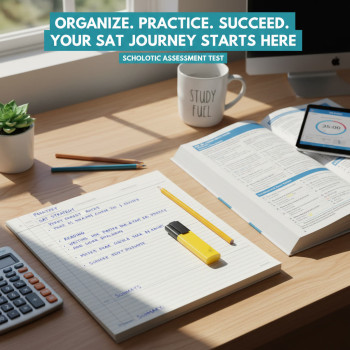Why mind maps are the secret weapon for Digital SAT success
Studying for the Digital SAT can feel like trying to drink from a fire hose: vocabulary lists, algebraic methods, data interpretation, reading strategies, essay structure (if you choose to write one), timing tricks, and the little habits that turn a shaky 620 into a steady 710. Mind mapping gives your study material a home that isn’t linear notes or a disorganized stack of flashcards. It’s visual, flexible, and — most importantly — built for the way your brain actually remembers and connects ideas.
Think of a mind map as a smart map of your knowledge: the central node is the SAT, branches are sections (Reading, Writing & Language, Math — No Calculator, Math — Calculator), and sub-branches are skills, question types, formulas, and common traps. When you can literally see how a concept connects to several question types, your recall in the test room becomes faster and more confident.
What mind maps do better than linear notes
- Show relationships: They let you spot patterns across sections (e.g., how data interpretation in Math and graphs in Reading share skills).
- Encourage active learning: Building a map is an active process — you summarize, categorize, and reframe information as you add it.
- Support spaced repetition: You can tag nodes with review intervals and focus on weak nodes first.
- Personalize memory cues: Add colors, icons, and short examples that make an idea uniquely memorable for you.
Choosing the right mind mapping tool for SAT prep
There’s a mind mapping tool for every style: simple pen-and-paper, desktop apps, or cloud-based tools that sync across devices. When choosing, look for these features:
- Cross-device sync: You want your last-minute review on a phone to match your desktop study map.
- Easy reorganization: Drag-and-drop nodes so you can merge, split, or move topics as you learn more.
- Visual options: Colors, icons, and attachments (like practice question screenshots) help memory.
- Export and print: Good for creating condensed review sheets.
Not every map needs every feature. If you work best by handwriting, a large poster and colored pens can be more powerful than a complex app. If you prefer structure and analytics, a digital tool that tracks node edits and time spent can reveal where you’re wasting study time.
How to set up your first SAT mind map — step by step
If you’ve never created a mind map, the process is surprisingly calming. Here’s a step-by-step workflow tuned specifically for SAT preparation.
1. Start with a central node
Write “Digital SAT” or simply “SAT” in the center. Keep it short — the center is a launchpad, not an essay.
2. Create main branches for each section
- Reading
- Writing & Language
- Math — No Calculator
- Math — Calculator
- Test-taking strategies / timing
- General review / vocabulary
These branches mirror the test’s structure and give you a place to drop related nodes.
3. Add sub-branches for question types and skills
For example, under Reading add: main idea, inference, evidence support, author tone, and paired passages. Under Math, add algebra, problem solving, advanced geometry, data analysis, and formula recall.
4. Populate each node with bite-sized items
Don’t try to write an explanation in the node — instead, use single phrases and examples. For instance, under “Inference” you might write: “what’s implied, not explicit — ask: what must be true?” and attach a short example question or paraphrase one you missed on a practice test.
5. Color-code and tag nodes
Choose a consistent color system. Example:
- Red = must master (frequent mistakes)
- Orange = partially confident
- Green = mastered
Digitally, tags can be “review weekly,” “practice test error,” or “vocab.” If you’re using an app, consider tags that sync with your calendar for scheduled reviews.
6. Link nodes across branches
One of the biggest powers of mind maps is linking. Connect “data interpretation” under Reading to “data analysis” under Math. This helps you notice that the same approach — sketching the trend, noting axis labels, estimating ranges — applies in both sections.
Templates and examples: what a good SAT mind map looks like
Below are two condensed templates you can adapt. Use them as starting points and expand as your weaknesses emerge.
| Central Node | Main Branches | Example Sub-Branches |
|---|---|---|
| Digital SAT | Reading | Main idea, Inference, Evidence, Author tone, Paired passages, Graphs in passages |
| Digital SAT | Writing & Language | Verb tense, Parallelism, Sentence structure, Punctuation, Concision, Transition words |
| Digital SAT | Math — No Calc | Algebra basics, Linear equations, Ratios, Simple geometry, Number properties |
| Digital SAT | Math — Calc | Advanced algebra, Functions, Trig basics, Data analysis, Modeling |
Use this table to copy into a digital canvas or draw it by hand, then expand each cell into its own branch with examples.
Concrete examples: building a node from a missed question
Real improvement happens when you build map nodes from the practice test mistakes you make. Here’s how:
- Write the question type as the node title (e.g., “Reading: Evidence Support #27”).
- Under the node add: what you answered, why, and the correct reasoning in one sentence.
- Attach a short “rule” and a 10-word strategy (e.g., “locate line/reference, paraphrase, confirm with text”).
- Tag the node with a review date and link it to similar nodes.
Example node content: “Evidence Support — I chose B because it sounded right; correct: C because it cites line 34 and explains causal link. Strategy: always match claim phrase-for-phrase to text.” Over time, nodes like this become a highly personalized error journal you can skim the week before a test.
Timing and routine: using maps with your study plan
A mind map alone won’t replace consistent practice — but it will make practice more targeted. Here’s how to fold mind mapping into your weekly routine.
- Weekly review session (60–90 minutes): update your map with new errors from the latest practice test.
- Daily micro-reviews (10–20 minutes): open your map on your phone and quiz nodes tagged “daily” or “vocab.”
- Pre-test warm-up (30 minutes before a practice test): scan red nodes and one small branch you recently improved.
- Monthly synthesis (2–3 hours): prune irrelevant nodes, merge duplicates, and mark changes in confidence.
By the test week, your map should be a slim, color-coded cheat-sheet of strategies and recurring traps — not a sprawling forest of everything you once read.
Using mind maps to master SAT vocabulary and grammar
Vocabulary on the Digital SAT is more context-driven than list-driven. Mind maps help you organize words by usage, not just definition.
How to map vocabulary effectively
- Create nodes for word families (e.g., “-cede/ceed/cess” with meanings like “go/yield”).
- Make example-sentence subnodes: short sentences showing common collocations.
- Tag words by difficulty and frequency (how often they’ve shown up in practice tests).
- Link words to grammar nodes when relevant (e.g., “affect/effect” under Writing & Language).
For grammar, make a “Rule & Signal” branch in Writing & Language. Under “Subject-Verb Agreement” add quick signals like “none, each, every = singular” and attach a 15-second explanation. These short capsules are what you’ll want to glance at during a timed section.
How mind maps sharpen math problem solving
Math often boils down to recognizing problem types and applying a known set of tools. A mind map turns that recognition into a reflex.
Math node ideas
- Equation archetypes: linear, quadratic, systems — with a one-line solution checklist.
- Common traps: forgetting to check domain, misreading units, sign errors.
- Quick formulas: slope, midpoint, special right triangles, circle rules — each as its own attachable node.
- Graph-reading heuristics: identify axes, check units, estimate slopes before calculating.
When you practice a mock section and miss a question, create a “Missed: Algebra #12” node and attach the original problem (or a paraphrase), your approach, and the better approach. Over time, you’ll develop a library of micro-lessons to revisit.
Advanced techniques: layering mind maps with spaced repetition and analytics
Combine the visual power of maps with proven memory techniques for maximum retention.
Tagging for spaced repetition
Use tags like “S1” (review 1 day), “S3” (3 days), “S7” (7 days), and “S30” (30 days). When you get a node right during review, move it to the next tag. When you miss it, move it back to S1. This creates a personalized review cadence built into your map.
Using analytics
If your mind mapping tool supports activity tracking, use time-spent and node-edit counts to spot trouble spots. If you’re working with a tutor — like Sparkl’s personalized tutoring — these analytics help your tutor design a targeted 1-on-1 session that focuses on the nodes where you repeatedly slip. Sparkl’s expert tutors can translate map patterns into tailored study plans and offer AI-driven insights that align practice sessions with your weak nodes.
Troubleshooting common problems students face with mind maps
Mind maps are powerful, but only if you avoid a few common pitfalls.
Too big, too vague
It’s easy to dump whole chapters into a single node. Instead, keep nodes specific: “Parabola vertex shift — identify a,b,c quickly” is better than “Quadratics.”
Overdecorating
Colors and icons are useful, but if you spend more time beautifying than practicing, you’re procrastinating. Keep visual aids strategic: one color for urgency, one icon for problem type.
Not updating after mistakes
The map’s real value is its feedback loop. After every practice test, spend focused time converting mistakes into nodes. This transforms one-off failures into repeatable improvements.
Study session blueprints using mind maps
Here are three practical session templates you can adapt depending on your time and stage of preparation.
30-minute daily micro session
- 5 minutes: quick scan of red nodes.
- 15 minutes: targeted practice on one red node (one mini-quiz or 5 focused questions).
- 10 minutes: update the node and tag the next review.
90-minute deep focus
- 20 minutes: take a short practice set (timed).
- 30 minutes: analyze mistakes and create nodes for each error.
- 30 minutes: practice alternate strategy for those errors and update map confidence.
Simulated test day (3–4 hours)
- Full practice section simulation using official digital practice tools.
- Immediate debrief: create 10–12 nodes from errors and label with S1 tag.
- Evening review: quick pass through S1 nodes and plan a follow-up session with a tutor or study partner.
If you work with a tutor — Sparkl’s 1-on-1 guidance is particularly effective here — schedule the debrief session with your tutor within 24–48 hours. Their feedback will help you rewrite nodes with clearer strategies and smarter examples.
Measuring progress: what to track on your mind map
Mind maps become more useful when they’re also measurement tools. Keep a small “Progress” branch on your central map with the following table to record outcomes after each practice test.
| Date | Practice Test Score | Top 3 Weak Nodes | Action Planned |
|---|---|---|---|
| 2025-09-01 | 620 | Inference, Algebra manipulations, Unit conversions | Daily 15-min inference drills; tutor session on algebra; 1-week unit conversion set |
| 2025-10-01 | 685 | Graph reading (improved), Advanced algebra (still shaky), Vocab usage | Weekly graph review, more targeted algebra nodes, vocab family mapping |
Updating this table after each full-length practice gives you a visual arc of progress that pairs well with your map’s color-coded nodes.
Collaborative mapping: study partners and tutors
Mind maps shine when used collaboratively. Swap maps with a peer to discover how they chunk information differently. A tutor can be especially valuable: they’ll spot incorrect reasoning in nodes and show you better heuristic shortcuts.
If you’re using Sparkl’s personalized tutoring, consider sharing your map with your tutor before a session. Tutors can pinpoint which nodes to address during a 1-on-1 meeting, prioritize areas where AI-driven insights show recurring mistakes, and help you develop tailored study plans that map directly to your weakest nodes.
Final tips: make your map test-ready and exam-friendly
- Trim two weeks before the test: consolidate and prune nodes so your map is a quick-reference tool, not a research paper.
- Create a “Test Warm-Up” branch with 3–5 last-minute reminders (e.g., read questions carefully, estimate before calculating, flag hard items and return later).
- Practice map retrieval: once a week, try to recreate a branch from memory and then compare to the original. This builds recall speed.
- Use examples you actually missed. The best nodes are built from your own errors, not someone else’s handout.
Conclusion: mind maps make the Digital SAT manageable and personal
The Digital SAT isn’t an endless test of stamina — it’s a test of pattern recognition, strategy, and calm execution. Mind mapping turns your scattered notes into a strategic playbook: you see patterns, prioritize practice, and build a memory scaffold that’s uniquely yours. Pairing this with targeted help — whether a focused study buddy or Sparkl’s expert tutors offering individualized 1-on-1 guidance and AI-informed recommendations — accelerates progress and keeps your study plan efficient.
Start with one branch today. Map a single mistake from a practice question and watch how quickly that tiny node becomes a repeated improvement. Over weeks, a network of small, corrected errors becomes a big jump in confidence and score. That’s the quiet power of mind mapping: small, visible changes that add up to a test-day performance you’re proud of.
Good luck — and remember: preparation that’s visual, active, and personalized is the kind that sticks. Map it, practice it, and then outperform it.

















No Comments
Leave a comment Cancel